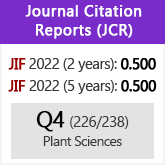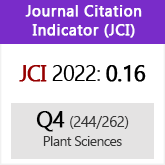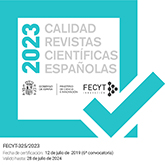Photosynthetic response and zonation of three species of Gelidiales from Tenerife, Canary Islands
DOI:
https://doi.org/10.3989/ajbm.2280Keywords:
Canary Islands, ecophysiology, Gelidiales, Gelidium, photosynthesis, PterocladiellaAbstract
Three species of Gelidiales (Gelidium arbuscula, Gelidium canariense and Pterocladiella capillacea) (Rhodophyta) were selected due to their abundance in the marine lower intertidal of the north coast of the island of Tenerife (Canary Islands), to assess, using PAM fluorescence, the importance of irradiance and exposure to air on vertical distribution. We compared tolerance to emersion by air-drying fronds under simulated emersion, and results suggest that recovery of photosynthesis after emersion plays a major role in the vertical distribution of these three species. Morphological traits such as clumped fronds explain the higher tolerances, and reduced water loss of the species upper on the shore. Local differences between sites may be related to slight differences in the light regime related to topography.
Downloads
References
Beer, S. & L. Axelsson. 2004. Limitations in the use of PAM fluorometry for measuring photosynthetic rates of macroalgae at high irradiances. European Journal of Phycology 39: 1-7. http://dx.doi.org/10.1080/0967026032000157138
Bischof, K., Gómez, I., Molis, M., Hanelt, D., Karsten, U., Lüder, U., Roleda, M.Y., Zacher, K. & Wiencke, C. 2006. Ultraviolet radiation shapes seaweed communities. Reviews in Environmental Science and Biotechnology 5: 141-166. http://dx.doi.org/10.1007/s11157-006-0002-3
Chapman, A.R.O. 1973. A critique of prevailing altittudes towards the control of seaweed zonation on the seashore. Botanica Marina 16: 80-82. http://dx.doi.org/10.1515/botm.1973.16.2.80
Chapman, A.R.O. 1974. The ecology of macroscopic marine algae. Annual Review of Ecology and Systematics 5: 65-80. http://dx.doi.org/10.1146/annurev.es.05.110174.000433
Dring, M.J. & Brown, F.A. 1982. Photosynthesis of intertidal brown algae during and after periods of emersion: a renewed search for physiological causes of zonation. Marine Ecology Progress Series 8: 301-308. http://dx.doi.org/10.3354/meps008301
Flores-Moya, A., Gómez, I., Viñegla, B., Altamirano, M., Pérez-Rodríguez, E., Maestre, C., Caballero, R. & Figueroa, F.L. 1998. Effects of solar radiation on the endemic Mediterranean red alga Rissoella verruculosa: photosynthetic performance, pigment content and the activities of enzymes related to nutrient uptake. New Phytologist 139: 673-683. http://dx.doi.org/10.1046/j.1469-8137.1998.00233.x
Franklin, L.A. & Badger, M.R. 2001. A comparison of photosynthetic electron transport rates in macroalgae measured by pulse amplitude modulated chlorophyll fluorometry and mass spectrometry. Journal of Phycology 37: 756-767. http://dx.doi.org/10.1046/j.1529-8817.2001.00156.x
Genty, B., Briantais, J.M. & Baker, N.R. 1989. The relationship between the quantum yield of photosynthetic electron transport and quenching of chlorophyll. Biochimica et Biophysica Acta 990: 87-92.
Gevaert, F., Creach, A., Davoult, D., Holl, A.-C., Seuront, L. & Lemoine, Y. 2002. Photo-inhibition and seasonal photosynthetic performance of the seaweed Laminaria saccharina during a simulated tidal cycle: chlorophyll fluorescence measurements and pigment analysis. Plant, Cell and Environment 25: 859-872. http://dx.doi.org/10.1046/j.1365-3040.2002.00869.x
Gil-Rodríguez, M.C. & Wildpret, W. 1980. Contribución al estudio de la vegetación ficológica marina del litoral canario. Aula de Cultura Excmo. Cabildo Insular de Tenerife.
Gómez, I. & Figueroa, F.L. 1998. Effects of UV stress on chlorophyll fluorescence kinetics of intertidal macroalgae from southern Spain: a case study in Gelidium species. Journal of Applied Phycology 10: 285-294. http://dx.doi.org/10.1023/A:1008021230738
Hall, D.O. & Rao, K.K. 1999. Photosynthesis. Cambridge University Press, Cambridge.
Hanelt, D., Huppertz, K. & Nultsch, W. 1993. Daily courses of photosynthesis and photo-inhibition in marine macroalgae investigated in the laboratory and field. Marine Ecology Progress Series 97: 31-37. http://dx.doi.org/10.3354/meps097031
Hunt, L.J.H. & Denny, M.W. 2008. Desiccation protection and disruption: a trade-off for an intertidal marine alga. Journal of Phycology 44: 1164-1170. http://dx.doi.org/10.1111/j.1529-8817.2008.00578.x
Huppertz, K., Hanelt, D. & Nultsch, W. 1990. Photo-inhibition of photosynthesis in the marine brown alga Fucus gardneri as studied in field experiments. Marine Ecology Progress Series 66: 175-182. http://dx.doi.org/10.3354/meps066175
Lewis, J.R. 1964. The Ecology of Rocky Shores. English University Press, London.
Mercado, J.M., Niell, F.X. &. Gil-Rodríguez, M.C. 2001. Photosynthesis might be limited by light, not inorganic carbon availability, in three intertidal Gelidiales species. New Phytologist 149: 431-439. http://dx.doi.org/10.1046/j.1469-8137.2001.00050.x
Montalva, S. & Santelices, B. 1981. Interspecific interference among species of Gelidium from Central Chile. Journal of Experimental Marine Biology and Ecology 53: 77-88. http://dx.doi.org/10.1016/0022-0981(81)90085-X
Oates, B.R. & Murray, S.N. 1983: Photosynthesis, dark respiration and dessication resistance of the intertidal seaweeds Hesperophycus harveyanus and Pelvetia fastigiata f. gracilis. Journal of Phycology 19: 371-380. http://dx.doi.org/10.1111/j.0022-3646.1983.00371.x
Pérès, J.M. 1982. Zonations and organismic assemblages. In: Kinne, O. (ed.), Marine Ecology, Vol. V, Ocean management, Part 1. Wiley, Chichester, pp. 9-576.
Pinedo, S. & J. Afonso-Carrillo. 1994. Distribución y zonación de las algas marinas bentónicas en Puerto de la Cruz, Tenerife. Vieraea 23: 109-123.
Rico, J.M. 1991. Field studies and growth experiments on Gelidium latifolium from Asturias (N Spain). Hydrobiologia 221: 67-75. http://dx.doi.org/10.1007/BF00028363
Rico, J.M. & Fredriksen, S. 1996. Effects of environmental factors on net photosynthesis and growth of intertidal species of the genus Gelidium (Gelidiaceae, Rhodophyta) in northern Spain. Scientia Marina 60: 265-273.
Santelices, B. 1991. Production ecology of Gelidium. Hydrobiologia 221/222: 31-44. http://dx.doi.org/10.1007/BF00028360
Silva, J., Santos, R., Serodio, J. & Melo, R.A. 1998. Light response curves for Gelidium sesquipedale from different depths, determined by two methods: O2 evolution and chlorophyll fluorescence. Journal of Applied Phycology 10: 295-301. http://dx.doi.org/10.1023/A:1008057008447
Stephenson, T.A. & Stephenson. A. 1972. Life Between Tide- Marks on Rocky Shores. W.H. Freeman, USA.
Wiencke, C., Gómez, I., Pakker, H., Flores-Moya, A., Altamirano, M. Hanelt, D., Bischof, K. & Figueroa, F.L. 2000. Impact of UV-radiation on viability, photosynthetic characteristics and DNA of brown algal zoospores: implications for depth zonation. Marine Ecology Progress Series 197: 217-229. http://dx.doi.org/10.3354/meps197217
Williams, S.L. & Dethier, M.N. 2005. High and dry: variation in net photosynthesis of the intertidal seaweed Fucus gardneri. Ecology 86: 2373-2379. http://dx.doi.org/10.1890/04-1569
Downloads
Published
How to Cite
Issue
Section
License
Copyright (c) 2011 Consejo Superior de Investigaciones Científicas (CSIC)

This work is licensed under a Creative Commons Attribution 4.0 International License.
© CSIC. Manuscripts published in both the printed and online versions of this Journal are the property of Consejo Superior de Investigaciones Científicas, and quoting this source is a requirement for any partial or full reproduction.All contents of this electronic edition, except where otherwise noted, are distributed under a “Creative Commons Attribution 4.0 International” (CC BY 4.0) License. You may read here the basic information and the legal text of the license. The indication of the CC BY 4.0 License must be expressly stated in this way when necessary.
Self-archiving in repositories, personal webpages or similar, of any version other than the published by the Editor, is not allowed.

















